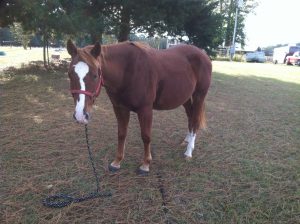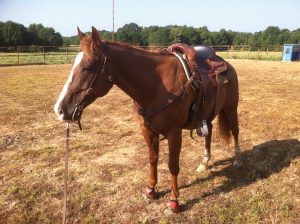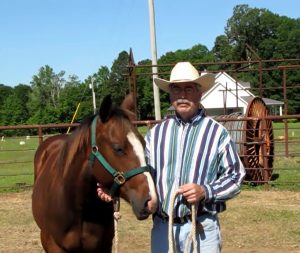 I’m not an expert horse trainer. I am, at best, a novice horseman…maybe more of a wannabe horseman…which is okay, too. My only horse experience has been working with our own horses. So, take my observations with a grain of salt…I have a fairly narrow experience spectrum in regard to horse behavior.
I’m not an expert horse trainer. I am, at best, a novice horseman…maybe more of a wannabe horseman…which is okay, too. My only horse experience has been working with our own horses. So, take my observations with a grain of salt…I have a fairly narrow experience spectrum in regard to horse behavior.
However, the more I work with horses the more I find myself thinking of them as natural comfort magnets. Horses naturally move toward what feels comfortable and they naturally move away from what feels uncomfortable. Their level of comfort or discomfort can be either physical or emotional…it often seems largely intuitive…which makes sense for prey animals. It’s important to avoid anything intuitively perceived as uncomfortable…potentially dangerous. It is equally important to gravitate toward comfort…food, water, shelter, safety.
I have begun to think of horsemanship as largely a matter of managing a horse’s comfort levels and comfort zones. Horsemen talk a lot about pressure and release. Pressure is basically mild discomfort applied to solicit a response. The release is basically comfort applied as positive reinforcement of desired behavior. So, pressure and release are basically just using comfort and discomfort as training aids.
Horsemen also talk a lot about desensitizing…training a horse to be comfortable with something that has previously made him anxious. Basically this is a matter of incrementally expanding the horse’s comfort zone. To desensitize my horse to an object, I expose him to it in small doses, letting him become comfortable with it first at a distance, then close up, then very close, then touching, then rubbing all over his body. I incrementally step him from terrified to comfortable by gradually expanding his comfort zone to include the object of concern.
The tricky part comes in knowing when to apply comfort, when to apply discomfort, and to what degree.
For example, let’s say a horse has been taught to load in a trailer and normally has no issue loading. But one day I go to load that horse and he balks. He backs away from the trailer door and doesn’t want anything to do with it. Now, a lot of horse owners at this point will say, “I hate when a horse knows what to do and refuses. He’s just being stubborn and defiant.” Acting on that basis, they will then firm up and apply increasing pressure (discomfort) outside the trailer with the intent of getting the horse to load in the trailer.
Sometimes that works. Sometimes that is exactly what the horse needs in order to find the confidence to go ahead and load in the trailer.
But sometimes that doesn’t work. Sometimes the horse will respond by more actively avoiding the trailer door. And here is where it gets tricky…
If I respond to my horse’s reluctance to load by firming up and assuming he is being defiant, my natural response to increased resistance will likely be to become even firmer and more aggressive. That can quickly escalate into a contest of wills which I cannot win…the horse is too much bigger and stronger than I. More significantly, by battling out a contest of wills right at the trailer door, I am turning the trailer door into a high pressure zone…a place of discomfort and suspicion…which is the opposite of what I want. A horse who loads easily is a horse who feels comfortable and confident both around the trailer door and inside the trailer.
Now, here’s where the comfort management comes in.
For whatever reason, the horse was initially uncomfortable with the trailer door on this particular day. My escalation of pressure didn’t work and resulted, instead in making him even more suspicious of the trailer door. I’m increasing pressure outside the trailer with the intent of getting him to move through the trailer door to escape the discomfort I’m creating. However, the situation is rapidly devolving to trap the horse between two escalating sources of discomfort. Most likely, the horse will attempt to escape both sources of discomfort by moving completely out of the area. He will probably try to flee the area, even if he has to buck or rear to do it.
At that point it’s probably best to walk away and try a different approach…maybe one that focuses more on comfort and less on discomfort. Successful trailer loading begins with the horse feeling very comfortable in and around the trailer.
Where the comfort management gets really fun is in realizing the horse is also sensitive to different levels of comfort and will tend to gravitate toward the more comfortable. If I’m going down the road and want my horse to move toward the left side, one way to cue that is to press with my right leg so my horse will move left, away from the pressure. I haven’t really caused any discomfort. I’ve just set up a situation of relative discomfort. I’ve made the right side feel a little less comfortable than the left side so the horse will move left, away from the less comfortable.
Once I started experimenting with relative comfort I wanted to see how light a cue my horse would respond to. Before long, I could get him to step left with just a light brush of my right leg. Then I decided to take it one step further. What if, instead of creating relative discomfort I created relative comfort? Rather than pressing with my right leg, I lifted my left stirrup away and my horse stepped left. The lifted stirrup created a lower pressure zone of increased relative comfort which the horse gravitated toward.
Rather than using mild leg pressure to push the horse the desired direction, the lifted stirrup sets up a mild comfort differential to invite the horse to step the desired direction. It’s the difference between leading versus pushing…the difference between inviting versus compelling. The really cool thing about this approach is I never did anything to cause discomfort under saddle. Instead, I invited him from a place of comfort to a place of greater comfort.
Comfort under saddle is important because my long-term goal for my horse is for me to be his greatest source of comfort. I want the place beneath my saddle and between my legs to be his greatest comfort zone. When we’re riding and encounter something he views as scary, I want him looking to me for direction, confidence and comfort rather than running scared.
Disclaimer: Lest I give the impression I’m a better horseman than I am, let me clarify that not every ride is as smooth and light as I have described here. Some rides are a bit rougher. Even most good rides require a couple of times using enough pressure to “give the horse a reason to respond to the light cue” as Carson James likes to say. However, some rides really are that light and smooth…and with practice those light rides are becoming more frequent.
Reflecting on the response of these horses to varying levels of comfort, I realize I’m not so different from a horse. I too am drawn toward comfort and repelled by discomfort. I also tend to gravitate toward the more comfortable. In tense or fearful situations, I too look for a source of comfort.
No wonder Jesus referred to the Holy Spirit as the Comforter!
But the Comforter, which is the Holy Ghost, whom the Father will send in my name, he shall teach you all things, and bring all things to your remembrance, whatsoever I have said unto you. (John 14:26)
Like my horse, in stressful situations I tend to flee to a place of comfort. There may be any number of comfort sources I may turn to…and there may be nothing wrong with many of them. However, sin can be addicting for the very reason that it provides temporary comfort…and any comfort source (other than Christ) raised to a high level of priority can become sinful.
Much like my goals for my horse, God’s goal for me is for the Holy Spirit to be my greatest source of comfort. My greatest comfort zone should be abiding in Him.
I am the vine, ye are the branches: He that abideth in me, and I in him, the same bringeth forth much fruit: for without me ye can do nothing. (John 15:5)
When I’m scared or stressed, I need to learn to run to Father for comfort and direction.
Let us therefore come boldly unto the throne of grace, that we may obtain mercy, and find grace to help in time of need. (Hebrews 4:16)
What a wonderful Savior, who leads us from comfort to comfort with light gentle cues!
Your thoughts?


